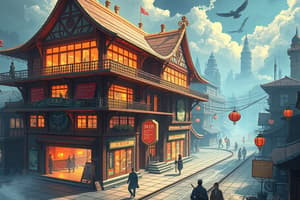Podcast
Questions and Answers
Which market structure is characterized by a single firm dominating the market?
Which market structure is characterized by a single firm dominating the market?
- Oligopoly
- Perfect Competition
- Monopolistic Competition
- Monopoly (correct)
Firms in a perfectly competitive market can influence the market price.
Firms in a perfectly competitive market can influence the market price.
False (B)
What is the main goal of all firms irrespective of their market structure?
What is the main goal of all firms irrespective of their market structure?
Profit maximization
In monopolistic competition, the type of product is _____ for firms.
In monopolistic competition, the type of product is _____ for firms.
Which market structure features a high ease of entry for new firms?
Which market structure features a high ease of entry for new firms?
Match the following market structures with their characteristics:
Match the following market structures with their characteristics:
Define average revenue (AR).
Define average revenue (AR).
In oligopoly, the number of firms is few, which can lead to price-setting behavior.
In oligopoly, the number of firms is few, which can lead to price-setting behavior.
What condition must be met for a firm to achieve profit maximization?
What condition must be met for a firm to achieve profit maximization?
Firms in a monopolistically competitive market can earn economic profits in the long run.
Firms in a monopolistically competitive market can earn economic profits in the long run.
What happens to the demand faced by incumbent firms when new firms enter a monopolistically competitive market?
What happens to the demand faced by incumbent firms when new firms enter a monopolistically competitive market?
A firm is said to have a _____ when it controls a key raw material necessary for production.
A firm is said to have a _____ when it controls a key raw material necessary for production.
Match the barriers to entry with their descriptions:
Match the barriers to entry with their descriptions:
Which of the following is NOT a reason for high barriers to entry?
Which of the following is NOT a reason for high barriers to entry?
Short-run economic losses in a monopolistically competitive firm lead to firms exiting the market.
Short-run economic losses in a monopolistically competitive firm lead to firms exiting the market.
What is the outcome when firms make zero economic profit?
What is the outcome when firms make zero economic profit?
Flashcards are hidden until you start studying
Study Notes
Market Structures
- Economists classify industries into four main market structures: Perfect Competition, Monopolistic Competition, Oligopoly, and Monopoly.
- Perfect competition is the only market structure where firms lack market power, meaning they cannot influence market prices.
- Classification of an industry into a market structure depends on three characteristics:
- Number of firms in the industry
- Similarity of goods or services produced
- Ease of entry for new firms
Characteristics of Market Structures
- Perfect Competition:
- Many firms
- Identical products
- High ease of entry
- Monopolistic Competition:
- Many firms
- Differentiated products
- High ease of entry
- Oligopoly:
- Few firms
- Identical or differentiated products
- Low ease of entry
- Monopoly:
- One firm
- Unique product
- Entry is blocked
Average and Marginal Revenue
- Average Revenue (AR) is calculated by dividing total revenue by the number of units sold.
- Marginal Revenue (MR) represents the change in total revenue from selling an additional unit.
- In perfectly competitive markets, MR equals the price of the good, while firms sell identical products.
Perfectly Competitive Market
- A perfectly competitive firm cannot affect the market price and is considered a price taker.
- Profit maximization occurs where Marginal Revenue (MR) equals Marginal Cost (MC).
Entry and Exit in the Long Run
- Economic profits attract new firms into an industry, while losses encourage exit.
- Monopolies maintain long-term economic profits due to high barriers to entry preventing new firms from entering the market.
- In a monopolistically competitive market, economic profit is short-lived as low barriers allow new firms to enter, driving profits to zero in the long run.
Effects of Competition on Profits
- Short-run economic profits in monopolistically competitive markets lead to increased product variety and decline in demand for incumbent firms.
- Conversely, short-run economic losses lead to firm exit, reducing product variety and increasing demand for remaining firms.
- Firms earning zero economic profit still obtain a positive accounting profit, making them willing to remain in the market.
Origins of Monopolies
- Monopolies arise from barriers to entry that inhibit competition, with four main reasons:
- Government restrictions prevent multiple firms from entering a market.
- Control of essential raw materials by one firm.
- Significant network externalities in service or product supply.
- Large economies of scale that lead to natural monopoly.
Studying That Suits You
Use AI to generate personalized quizzes and flashcards to suit your learning preferences.




